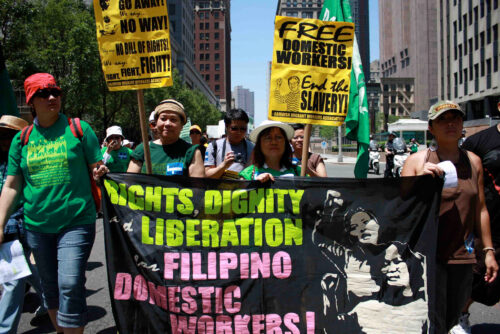The increasing prosperity of East Asia since the mid-1970s has stimulated substantial international migration within the region. It is estimated that the number of temporary migrant workers in Asia, with or without legal documents, reached 6.1 million by 2000.1 Women occupy one third of this migrant labor force, concentrated in particular occupations like the entertainment industry, health services, and especially domestic service.2 Migrant domestic workers in Asia originate from the Philippines, Indonesia, Sri Lanka, Thailand, and Vietnam, and they migrate to Hong Kong, Singapore, Taiwan and Malaysia.
The introduction of migrant domestic workers in this region is a practice that exacerbates the privatization of care encouraging people to continue to define housework and care work as a woman’s calling and a family duty. This practice thereby excuses the lack of care work done by the state or by men. One critical difference with this new practice is that women who can afford migrant domestic workers oversee the hiring of domestic work instead of doing the work themselves, thereby creating even more levels of hierarchy and exploitation. As I will argue in this essay, we should recognize care as an essential social right and public responsibility, rather than reducing it to a “parochial concern of women”3 or the devalued work of powerless minorities.
In East Asia, as in many other areas of the world, because most states have not established comprehensive welfare programs, the family is assumed to be the primary institution that guards the economic and social well-being of individual people. Policymakers praise and encourage three-generation cohabitation as a time-honored solution to childcare and eldercare. For example, in Japan and South Korea, grown children living with parents receive benefits like income tax reduction, preferential treatments of housing funds, and privileged entry into public housing.4 This romanticized image of family unity, however, obscures power inequalities along gendered and generational divides. The privatization of care in connection with the principle of familism exacerbates women’s subordination to the patriarchal family. For instance, while sons are expected to guard the welfare of aging parents, in fact, daughter-in-laws are burdened with the physical labor of eldercare.
Live-in migrant domestic workers enable many ethnic Chinese households in Taiwan, Hong Kong, and Singapore to maintain the socially perceived ideals of in-home care for children and the elderly. By recruiting migrant women as substitute mothers for their children and fictive relatives for their aging parents, employed women are able to mitigate their motherly guilt and avoid the stigma of consigning elders to nursing homes. This is a global solution to the local norms of familism and filial piety. Ironically, the idyllic picture of carework done within the family is staged against the sober backdrop of migrant domestic workers separated from their own children and families for extensive periods of time.
In my work I use the metaphor of migrant domestic workers as global Cinderellas5 to illuminate the complexity and paradoxes in their migratory trajectories: their relationship with employers is a combination of physical intimacy and social distance, and the impact of their migration is a juxtaposition of emancipation and oppression. Migrant women work overseas to escape poverty and stress at home; they also embark on the journey to expand life horizons and to explore modernity. After crossing national borders, they are nevertheless confined within the four walls of their employers’ households. At work they act with deference; only during days off are they able to dress and act as they wish. Although migrant women may partially achieve the goal of upward mobility in their material lives back home, Cinderella’s happy ending remains a fairy tale for many who remain trapped in the flow determined by patterns of international migration.
- Graziano Battistella, “International Migration in Asia vis-á-vis Europe: An Introduction,” Asian and Pacific Migration Journal 2.4 (2002): 405-414. [↩]
- Keiko Yamanaka and Nicola Piper, “An Introductory Overview,” Asia and Pacific Migration Journal 12.1-2 (2003): 1-19. [↩]
- John C. Tronto, Moral Boundaries: A Political Argument for an Ethic of Care, (New York and London: Routledge, 1993): 180. [↩]
- Byung Hyun Park and Han Oak Lee, “A Comparative Study on Housing Welfare Policies for the Elderly between Korea and JapanÑfocused on the Policy for Home Residence,” available at www.welfareasia.org (PDF). [↩]
- This article is based on my book, Global Cinderellas: Migrant Domestics and Newly Rich Employers in Taiwan (Durham, NC: Duke University Press, 2006). [↩]




